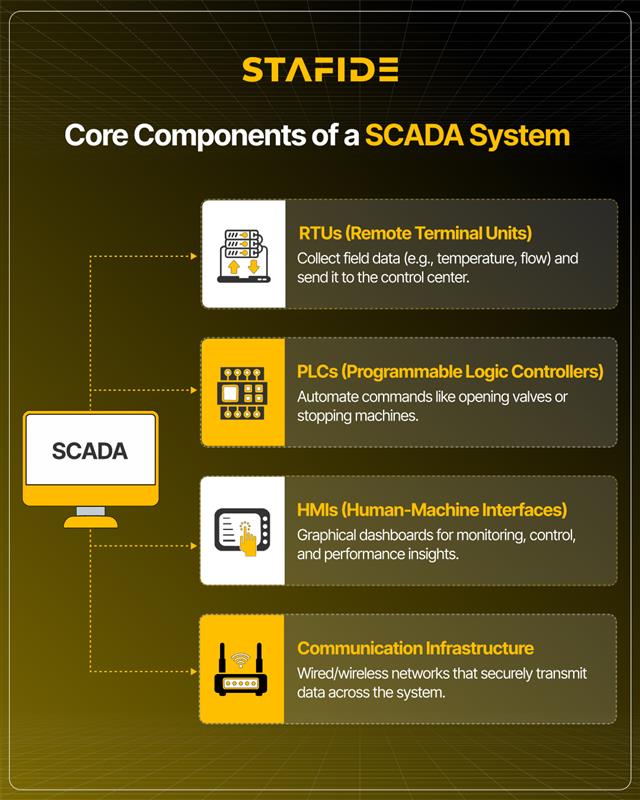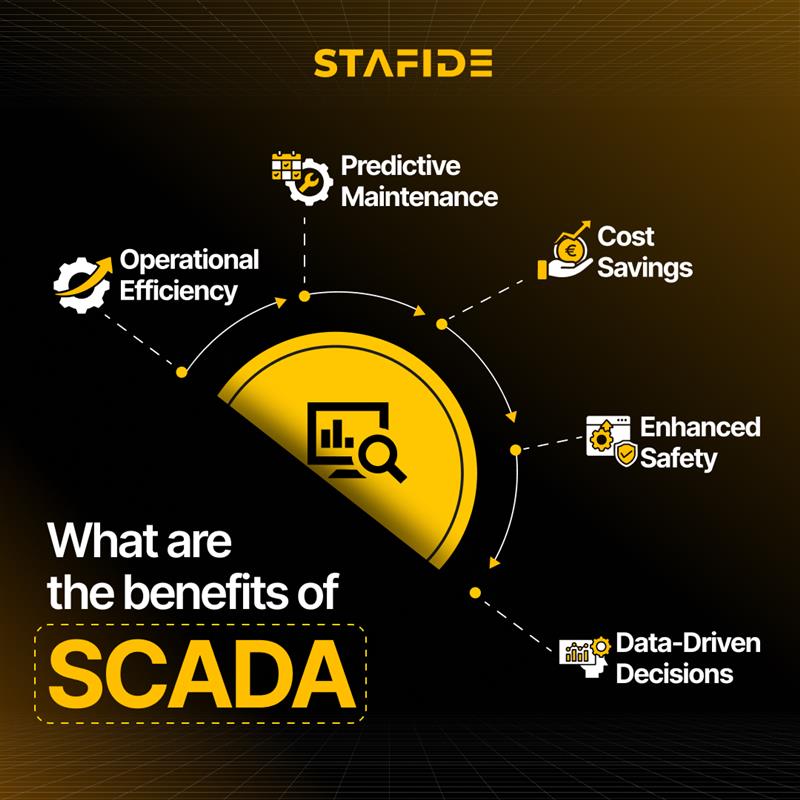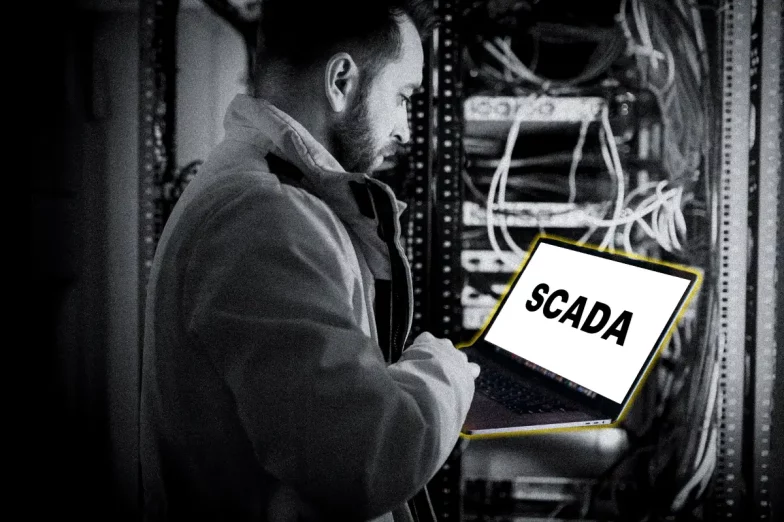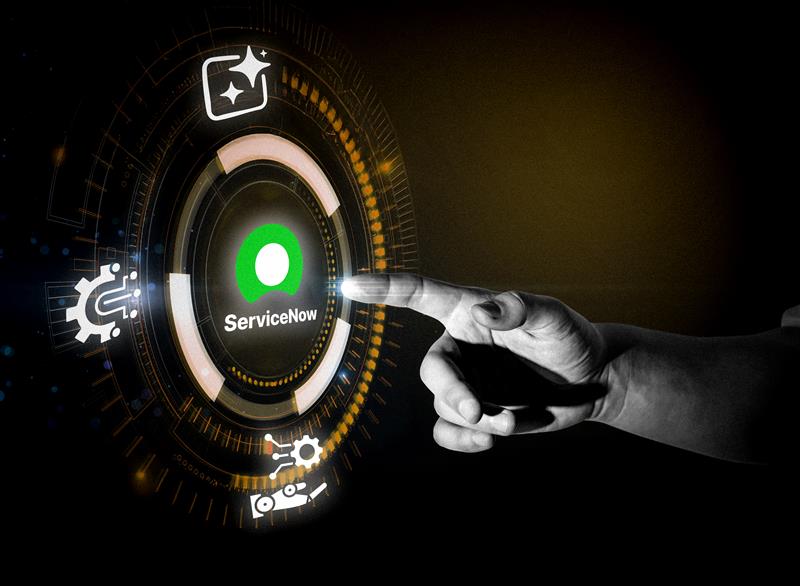From power grids to water treatment plants, much of the world’s essential infrastructure runs on systems we rarely see, but rely on every day. At the heart of these operations lies SCADA (Supervisory Control and Data Acquisition), a technology that silently orchestrates real-time monitoring, control, and automation. As industries grow more complex and data-driven, understanding SCADA’s role is key to unlocking safer, smarter, and more sustainable operations.
What is SCADA?
Supervisory Control and Data Acquisition (SCADA) systems are digital platforms that monitor and control industrial processes in real time. They act as the central nervous system of critical infrastructure—collecting, analyzing, and visualizing data to support safe and efficient operations.
SCADA systems typically include four main components:
- Remote Terminal Units (RTUs): These interface with field sensors and equipment to gather operational data such as temperature, pressure, or flow and send it to the control center.
- Programmable Logic Controllers (PLCs): Industrial-grade computers that execute automated commands like opening valves or stopping machinery.
- Human-Machine Interfaces (HMIs): Graphical dashboards used by operators to monitor systems, issue commands, and assess performance.
- Communication Infrastructure: Wired or wireless networks that transmit data securely between field devices and control systems.

Together, these elements deliver situational awareness and real-time control, helping organizations manage complex operations reliably.
The Layered Design of SCADA Systems
SCADA architecture is typically tiered. At the ground level, sensors and actuators collect environmental and operational data. RTUs and PLCs process this data locally and transmit it to a central SCADA server via Ethernet, cellular, or radio networks.
Operators interact with this centralized data through HMIs, which visualize conditions and enable decision-making. Increasingly, edge computing is used to allow local processing for time-sensitive actions, while cloud-based SCADA provides multi-site visibility, scalable analytics, and remote accessibility. This loop of data acquisition, transmission, visualization, and control forms the foundation for centralized operations.
Key Benefits of SCADA Across Industries
- Operational Efficiency: Automates tasks, minimizes human error, and enables 24/7 monitoring to boost productivity.
- Predictive Maintenance: Identifies wear-and-tear early through continuous data analysis, reducing unplanned downtime.
- Cost Savings: Cuts expenses by optimizing resource use, labor, and energy.
- Enhanced Safety: Triggers alerts or shutdowns when critical parameters breach safe limits.
- Data-Driven Decisions: Empowers teams to analyze trends and optimize performance based on real-time and historical data.

Real-World Impact: How SCADA Powers Diverse Industries
SCADA systems are essential in a wide range of sectors:
- Power & Utilities: Manage electricity flow, detect faults, and coordinate load-shedding.
- Oil & Gas: Supervise refineries, pipelines, and drilling rigs with real-time visibility and control.
- Water & Wastewater: Automate water treatment, monitor quality, and manage storm overflow.
- Manufacturing: Track machinery health, optimize production lines, and ensure consistent output.
- Transportation & Railways: Support real-time traffic coordination and power supply management.
- Renewable Energy: Optimize output in wind, solar, and hydro plants by integrating environmental data.
- Smart Buildings: Control HVAC, lighting, fire systems, and energy consumption for sustainability.
- Mining & Heavy Industry: Monitor systems like ventilation and conveyor belts to enhance safety and productivity.
- Food, Pharma, and Packaging: Ensure compliance, traceability, and consistent product quality through automated monitoring.
SCADA vs. EMS: Control Meets Efficiency
While SCADA focuses on real-time control and monitoring, Energy Management Systems (EMS) are designed to optimize energy usage. SCADA keeps processes running smoothly, while EMS reduces resource consumption by analyzing usage trends and automating efficiency improvements.
When integrated, SCADA can trigger actions based on EMS recommendations like adjusting operations during peak load times. This synergy is essential for businesses aiming to lower energy costs and meet environmental standards.
SCADA in the Age of AI, IoT, and Cloud
The convergence of SCADA with emerging technologies is unlocking new capabilities:
- Artificial Intelligence & Machine Learning: These tools enhance SCADA by predicting failures, spotting anomalies, and suggesting optimizations based on data patterns.
- IoT Sensor Networks: Affordable, smart sensors expand monitoring to granular levels, from vibration in pipelines to temperature fluctuations in storage units.
- Cloud-Based SCADA: Centralizes visibility across geographically dispersed assets, offering remote access, improved collaboration, and elastic storage and computing power.
These integrations shift SCADA from a passive control system to an intelligent platform that enables proactive, data-driven operations.
Cybersecurity in SCADA: Securing the Lifelines of Industry
As SCADA systems become more connected, they also become more exposed to cyber threats. Compromised SCADA can lead to power outages, contaminated water supplies, or disrupted manufacturing.
Key cybersecurity measures include:
- Network Segmentation: Isolating operational networks from enterprise IT systems to limit attack surfaces.
- Encrypted Protocols: Protecting data in transit from interception or tampering.
- Access Controls: Implementing role-based access and multi-factor authentication.
- Patch Management: Keeping systems up to date to close known vulnerabilities.
- Continuous Monitoring: Using intrusion detection systems to detect and respond to threats early.
With increasing global focus on critical infrastructure security, compliance with standards like NERC CIP or IEC 62443 is becoming a baseline expectation.
Sustainability and SCADA: Enabling Greener Operations
SCADA systems support environmental and sustainability initiatives by:
- Reducing Waste: Monitoring usage patterns helps optimize energy and resource consumption.
- Supporting Renewables: SCADA balances variable generation from solar or wind with operational demands.
- Tracking Emissions: Enables carbon accounting and compliance with ESG reporting requirements.
- Improving Efficiency: By scheduling energy-intensive processes during off-peak hours, SCADA lowers both environmental impact and operational costs.
In sectors with high energy demands or strict emission targets, SCADA becomes a key lever for driving greener operations.
Implementation Challenges and How to Overcome Them
Despite its advantages, SCADA implementation can face several obstacles:
- Legacy Equipment Compatibility: Older machines may not integrate easily. Using protocol converters and modular upgrades can ease this transition.
- Training Needs: Operators require skills to manage and interpret SCADA systems. Investment in training and simulation tools helps bridge this gap.
- Budget Limitations: High initial costs can be a barrier. Adopting scalable systems allows gradual rollout and faster ROI realization.
- Vendor Lock-In: Proprietary solutions can reduce flexibility. Favoring open standards and interoperable platforms prevents long-term dependency.
- Organizational Resistance: Change can be met with pushback. Pilot programs and transparent ROI communication can drive internal buy-in.
- Data Overload: Modern systems generate vast data volumes. AI and analytics platforms are crucial for filtering and surfacing actionable insights.
Partnering with experienced integrators and aligning implementation with business goals ensures smoother adoption and long-term success.
Conclusion: From Control to Strategic Intelligence
SCADA is no longer just a control tool; it is a strategic enabler. From powering critical operations to advancing sustainability and security, SCADA has evolved to meet the demands of modern infrastructure.
With AI, IoT, and cloud integration, SCADA is shifting from reactive oversight to predictive intelligence. As industries digitize, those investing in modern SCADA systems position themselves at the forefront of resilience, efficiency, and innovation.
Modern SCADA Starts with Strategic Talent
Modernizing SCADA demands the right blend of expertise and vision, balancing operational reliability with innovation. Stafide delivers future-ready talent equipped to drive intelligent automation, secure integration, and scalable infrastructure across industries. With the right capabilities in place, your organization is set to lead smarter, move faster, and thrive in the future of connected operations.





